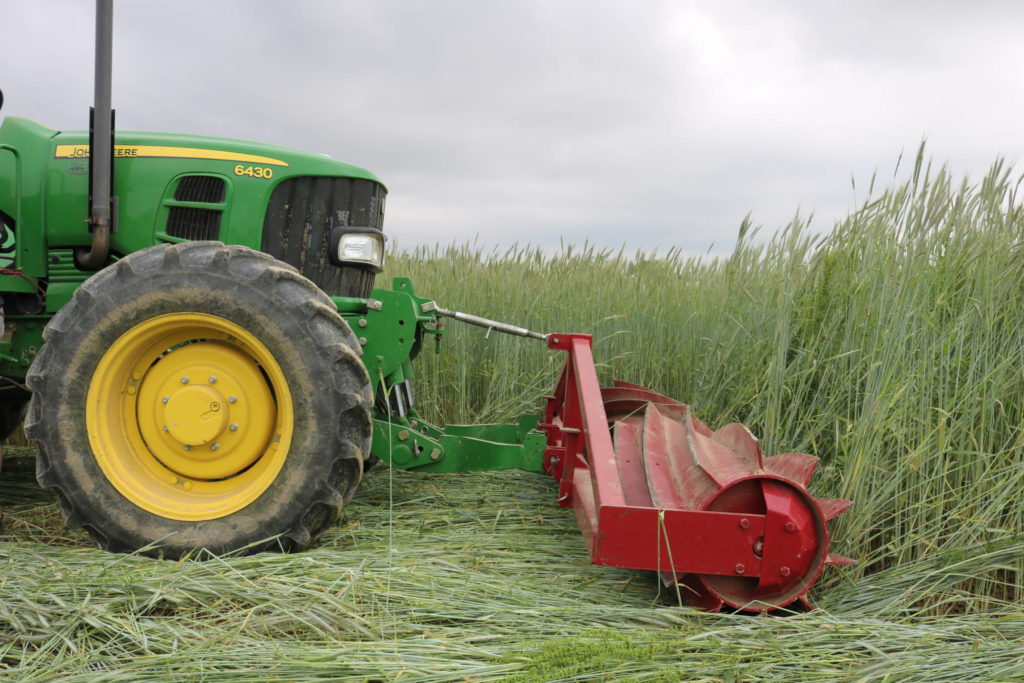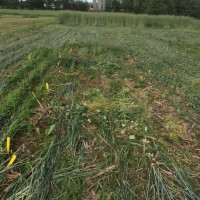Project Summary:
The Plants Protecting Plants: Removing Weed Habitat and Improving Crop Health Through the Use of Permanent Weed-Competitive Plant Species and Maintenance of Beneficial Soil Organisms demonstration project at Rodale Institute started in 2013 and was funded by a USDA NRCS PA EQIP FY 2013 Conservation Innovation Grant. The project was designed to demonstrate the efficacy of using low-growing, perennial understory plants as a weed management tool under four different land uses: 1. grain production, 2. vegetable production, 3. orchard production, and 4. livestock pasture.
Overall the goals of this project are to:
- Demonstrate the efficacy of converting current conventional agricultural practices to practices that enhance soil health using compost extracts and multiple species, permanent, low-growing native (MPLN) plants.
- Document that environmentally-friendly production systems reduce or eliminate the need for herbicide, maximize soil health, and maintain productivity of crops and pasture.
- Provide clear, concise information to farmers to enable them to use the above technologies to reduce or eliminate the use of herbicides and chemical fertilizers in their no-till systems, with the potential to dramatically reduce run-off, erosion and loss of nutrients to surface and groundwater.
- Generate practical, accessible, user-friendly outreach materials that will make these practices available to interested farmers.
- Disseminate and outreach this knowledge to growers throughout the region and country through workshops and educational materials.
To achieve these goals, project objectives focused on demonstrating a method to reduce dependence on synthetic herbicides while increasing soil health through treatments of compost extract and targeted understory plantings.
Specific project objectives were to:
Objective 1: Eliminate the need for annual applications of synthetic burn down herbicides by permanently establishing multi-species, perennial, low-growing, native plants that will reduce weed competition in their agricultural fields, thus saving the grower time and money.
Objective 2: Monitor the impacts of changes in soil health management on soil life, on compaction, on weeding requirements, and on visible fungal disease occurrence.
Objective 3: Quantify impacts of treatments on soil organic matter and yield.
Objective 4: Conduct on-farm demonstrations of project-oriented practices that optimize soil health.
Objective 5: Disseminate knowledge gained from on-farm and on-station demonstrations through field day events, farmer meetings, Rodale Institute’s web site, and a fact sheet.
Perennial understory plants have been used effectively as a weed management tool in semi-arid environments in the U.S. Great Plains as well as in Australia, but this management technique has not been tried in the sub-humid environments in Eastern U.S. In addition, the mixing of perennials and annuals has also been used in other ways in Australia where annuals are planted into perennial pastures, rather than perennials planted into annuals or perennials planted into other perennials. A previous study at Rodale Institute showed that maintaining permanent non-crop understory plants reduces weed pressure, diseases, and insect pests and improves water-holding and crop root depth. Planting a nitrogen-fixing plant as a permanent, perennial protection in a flower bed reduced weeding hours by 37.5% in the first year and 87.5% in the second year. In these same beds, root depth of plants doubled or tripled after two years requiring less irrigation and less compaction, which reduced run-off.
Using perennial plants in organic grain and vegetable crop production systems would typically be seen as a challenge because tillage is the most widely used weed management tool in organic agriculture, but the Rodale Institute Roller-Crimper (Figure 1) allows for management of a perennial understory crop prior to planting an annual crop that does not terminate the perennial crop (Figure 2). Flynn et al. (2013) found that perennial ground covers may effectively control weeds in corn production, but slower-growing perennials have less of an impact on yield.

Perennial understory plants also may be advantageous in organic orchards, where tree row weed management often damages trees, disturbs soil structure, and reduces nutrient availability by enhancing residue decomposition. This type of a ‘sandwich’ system with grasses, legumes, and grass-legume mixtures growing between tree rows has proved to be effective if the focus is on low-growing, stolon-building species (Korte et al., 2010).
The concept of pasture-cropping is growing rapidly, as cropland and rangeland managers are finding that the integration of an annual crop into a perennial pasture, particularly in a semi-arid environment, enhances water-use efficiency, improving production for both the annual and perennial crops (Ward et al., 2014). In this Plants Protecting Plants demonstration project, researchers examined the use of an herbaceous perennial in a perennial pasture to increase forage productivity while keeping the soil covered during low forage production periods.
Prior to planting, the seeds of the perennial, understory plants will be treated with a compost extract solution to return a diverse mix of soil organisms to the soil (Holland and Coleman, 1987; Ingham and Rollins, 1985). Previous research has shown that treating seeds with compost extract enhances the probability of germination. The microbes within compost extract may also help control soil borne pathogens and may reduce weed seed germination and growth. The benefits of improving specific groups of soil organisms may suppress diseases, improve soil organic carbon, reduce weed pressure and hold more water in the soil. Exudates from the roots of the living perennial plants will feed soil microorganisms and stimulate diversity in soil biota to enhance soil health.

The innovative weed management strategy summarized here has the potential to eliminate the need for herbicides, reduce compaction, erosion, and run-off, and improve rooting depths, which increases water-use efficiency and pollinator habitats. To achieve the goals and objectives of this demonstration project, three phases of activities will be conducted: 1. Identify the appropriate low-growing perennials plants; 2. Determine how to plant the seeds after inoculating them with a compost extract solution; and 3. Measure the success of these plants in covering the soil surface, competing effectively against weeds, enhancing soil health, and increasing yields.
References:
Flynn, E. S., K.J. Moore, J.W. Singer, and K.R. Lamkey. 2013. Evaluation of Grass and Legume Species as Perennial Ground Covers in Corn Production. Crop Science 53(2): 611-620.
Korte, N., and S. Porembski. 2010. Suitability of different cover crop mixtures and seedlings for a new tree row management in an organic orchard. Gesunde Pflanzen 62(2): 45-52.
Holland, E. A., and D. C. Coleman. 1987. Litter placement effects on microbial and organic matter dynamics in an agroecosystem. Ecology: 425-433.
Ingham, R.E., and C.A. Rollins. 1985. Interactions of bacteria, fungi, and their nematode grazers: effects on nutrient cycling and plant growth. Ecological Monographs 55(1): 119-140.
Ward, P.R., R.A. Lawes, and D. Ferris. 2014. Soil-water dynamics in a pasture-cropping system. Crop and Pasture Science 85(10): 1016-1021.
Author Acknowledgments:
The author would like to thank Dr. Elaine Ingham for her contributions to developing this project and Dr. Gladis Zinati, Associate Research Scientist, Rae Moore, former Research Technician, and Marisa Wagner, Research Technician, as well as the following research interns: Aprile Doubt, Guillaume Tant, Kari Bender, Erin Ball, Emily Lesher, Britta Schumacher, Scott Vondy, Miranda Lachman, and Lily Draklellis – for their invaluable assistance in this project.
Acknowledgment Clause:
This material is based upon work supported by the Natural Resources Conservation Service, U.S. Department of Agriculture, under Grant Agreement Number 69-2D37-13-670. Any opinions, findings, conclusions, or recommendations expressed in this publication are those of the author(s) and do not necessarily reflect the view of the U.S. Department of Agriculture.
For more updates on Rodale Institute’s research and programming, follow us on Facebook, Instagram, and Twitter.

